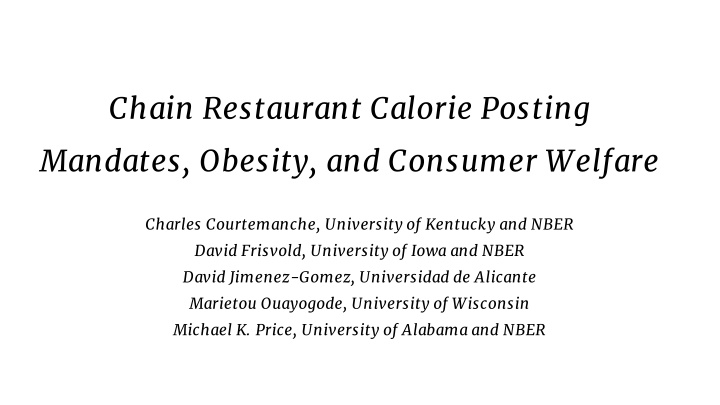Chain Restaurant Calorie Posting Mandates and Nudges
Exploring the impact of calorie labeling mandates on consumer welfare and obesity rates in chain restaurants. Analyzing why nudges work and how calorie labels influence consumer behavior and decision-making.
Download Presentation

Please find below an Image/Link to download the presentation.
The content on the website is provided AS IS for your information and personal use only. It may not be sold, licensed, or shared on other websites without obtaining consent from the author.If you encounter any issues during the download, it is possible that the publisher has removed the file from their server.
You are allowed to download the files provided on this website for personal or commercial use, subject to the condition that they are used lawfully. All files are the property of their respective owners.
The content on the website is provided AS IS for your information and personal use only. It may not be sold, licensed, or shared on other websites without obtaining consent from the author.
E N D
Presentation Transcript
Chain Restaurant Calorie Posting Mandates, Obesity, and Consumer Welfare Charles Courtemanche, University of Kentucky and NBER David Frisvold, University of Iowa and NBER David Jimenez-Gomez, Universidad de Alicante Marietou Ouayogode, University of Wisconsin Michael K. Price, University of Alabama and NBER
Motivation According to the OECD, healthcare accounts for over 16% of GDP in the US and 9% in the EU In the US, obesity alone accounts for 10% of healthcare costs Behavioral interventions have showed great promise in improving health outcomes A "nudge" is (Thaler and Sunstein, 2008): a subtle change in the environment that influences people's behavior in predictable ways, without restricting their choices or significantly altering their economic incentives We analyze a calorie labels nudge that incorporates calorie information on restaurant menus
Motivating Problem: Why Do Nudges Work Shift focus from evaluating whether a given policy works to understanding why a policy works Allow academics to derive welfare effects of different policies and refine models of choice Allow policymakers to identify new policy instruments or improve effectiveness of existing policies Open question: What drives changes in behavior?
Calorie Labels Matter Improve consumer welfare Some systematically underestimate calories consumed at restaurants despite availability of hidden information Improved salience could address information imperfection. Healthier food choices, less obesity, and greater utility But also in a way that hurts consumer welfare Nudges may influence choice by imposing psychic cost (moral cost, shadow tax, guilt) (Glaeser, 2006; Levitt and List, 2007; Andreoni and Rao, 2011; Della Vigna et al., 2012) Similarly, calorie labels may trigger guilt or shadow tax on high calorie items People consume fewer calories and make healthier choices. But may be worse off than if did not observe label This is our main point of departure from prior studies examining the effects of calorie labeling on food choices or weight
What We Do Explore these issues in the context of mandates for chain restaurants to post calorie counts on menus/menu boards Salience of the information nudges individuals to make healthier choices Calorie posting provision in the Affordable Care Act (ACA) took effect in 2018 We study local/state mandates that took effect prior to the ACA Our main objectives: Develop theoretical model of calorie labels to guide empirical analysis and interpretation of results Examine patterns of impacts on obesity and consumer well-being in an attempt to begin to understand not just whether calorie labeling nudges work , but also why
Overview of empirical results 1. Calorie labels reduce calorie consumption for everyone 2. Calorie labels have heterogeneous welfare effects: a. Welfare is reduced for those with healthy BMI b. But not for those who are overweight/obese
A Theory of Calories and Meal Choices Individuals select a meal x given a menu and also choose outside calories in a given choice environment e Meal calories Total calories Environment e = 0 means no nudge, and e = 1 means that the nudge (calorie labels) is active The individual has beliefs meal, and these depend on the environment about the calories of the
A Theory of Calories and Meal Choices Experienced utility: non-informational internality meal utility optimal weight function moral cost Decision utility:
A Theory of Calories and Meal Choices Assumptions: 1. The marginal non-informational internality is smaller with the nudge 2. Marginal moral costs are higher with the nudge 3. Beliefs about calories become more accurate with the nudge 4. Without the nudge, individuals do not underconsume and do not overestimate calories Proposition 1. Calorie labels (weakly) reduce the amount of calories consumed at the restaurant, as well as the total amount of calories consumed.
Empirical result I: Nudge decreases calories consumed
Background on Calorie Labels The 2010 Affordable Care Act (ACA) introduced a national mandate requiring chain restaurants and retail food establishments with 20 or more locations to post calories on menus and menu boards The start date of this mandate was repeatedly delayed but ultimately implemented in 2018 Some local/state jurisdictions passed mandates prior to the ACA Policymakers in many jurisdictions where mandates had passed shortly before the ACA never implemented them because of uncertainty about the final rules of the ACA mandate and the potential costs to restaurants to adopt certain menu labels only to change them when the ACA mandate took effect
Empirical Strategy: Exploit Geographic Heterogeneity Differences in strength of enforcement across locations: some passively enforce Worked with a health policy expert to distinguish laws that were implemented, enforced, and never repealed from those that were either repealed or never enforced Expert supplemented exhaustive review of legal statutes and media articles regarding state and local health departments and revealed substantial variation in the level/duration of enforcement of the implemented laws
Empirical Strategy: Local Mandates Date of Implementation # of Establishments Localities Passed and Actively Enforced New York City, NY Westchester County, NY (NYC MSA) Philadelphia City/County, PA Montgomery County, MD (DC MSA) Schenectady County, NY (Albany MSA) Suffolk County, NY (NYC MSA) April 2008 June 2009 January 2010 July 2010 October 2010 November 2010 15 15 15 20 15 15 Passed but Passively Enforced Seattle (King County, WA) January 2009 15 Albany County, NY April 2010 15 State of Vermont January 2011 20
Identification Strategy: BRFSS Data Use data from Behavioral Risk Factor Surveillance System (BRFSS) to examine impact of local mandates Changes in BMI (proxy for caloric intake) Changes in life-satisfaction (proxy for consumer welfare) Differences in outcomes after implementation across locations with mandate (treatment group) and nearby counties (control group) Heterogeneity across areas depending on stringency of enforcement
Sample Frame: BRFSS Data Telephone survey focusing on health and health behaviors Conducted by state health departments and CDC Repeated cross sections of randomly sampled adults County identifiers available for 1994-2012 Ending sample in 2012 avoids confounding from major chains voluntarily posting calories Question about life satisfaction available for 2005-2010 594,364 observations in total
Expand Data: Role of Information Content Are effects different in areas with lax enforcement? Likelihood that restaurants report posting calories Likelihood that consumers report noticing calories on menus We constructed a novel dataset by Phone surveys of all chain restaurants in sample areas to check if they are currently posting calorie counts on menus (called 15,099 restaurants) Survey of 5,228 individuals living in sample areas (Survey 1) asking if they have noticed calorie counts on menus when eating out
BMI Effects: Regression Analysis We also consider variant that allows effects to differ across counties that actively and passively enforce local mandates: the law was implemented but is not currently actively enforced the law was passed but not yet implemented
BMI Effects: Regression Analysis (1) (2) Law Implemented -0.174** (0.081) -0.191* (0.099) Law Implemented but No Longer Actively Enforced 0.126 (0.121) 0.001 (0.099) 594,364 26.711 Law Passed but Not Yet Implemented Sample size Mean of Outcome 594,364 26.711
BMI Effects: Interpreting the Magnitude Implementation of calorie posting laws reduce BMI by 0.19 Decrease of approximately 0.7 Kg Decrease of 0.7% Roughly due to a decrease of 105 calories consumed per week Average household eats 5 meals per week away from home (Saksena et al., 2018) 40% of restaurants would be required to post calories (chains with 20 locations) => 2 meals per week affected by calorie posting requirements => BMI results due to a decrease of 53 calories consumed per meal at chain restaurants
Results are robust Drop county trends Shorter pre-treatment periods Exclude adjacent counties Cluster standard errors by state or treatment area rather than county Control group based on population density rather than proximity Synthetic control group Using event study methods Placebo tests with pre-dated treatments to examine pre-trends Recent DD methods (Borusyak, Jaravel & Spiess, 2024) Controlling for avg. calories consumed outside the home, avg. food prices Controlling for smoking, exercise Vary control variables or drop all control variables
BMI Effects: Ruling out Compensating Behavior Minutes per Week Vigorous Exercise Minutes per Week Moderate Exercise -3.283 (3.419) Drinks per Month -0.167 (0.379) P(Any Exercise) 0.001 (0.012) P(Smoker) 0.001 (0.007) Law Implemented 0.828 (1.946) Law Implemented but No Longer Actively Enforced 0.016** (0.006) 0.064 (0.381) 0.008 (0.010) 2.083 (2.915) 1.734 (1.475) Law Passed but Not Yet Implemented -0.007 (0.005) -1.037* (0.576) 0.012 (0.009) -0.717 (2.307) 0.965 (1.749) Sample Size Mean of Outcome 591,432 0.192 526,857 10.979 545,840 0.762 194,705 49.600 194,705 30.093 More robustness checks
BMI Effects: Comparison to Field Experiments Our estimates (BMI by 0.17) are lower than predicted from field experiments Wisdom et al. (2010): of 99 calories in a meal => BMI by 0.75 VanEpps et al. (2016): of 60 calories => BMI by 0.47 Cawley et al. (2018): of 45 calories => BMI by 0.35 Individuals can avoid calorie labels by choosing restaurants that are not required to post calories (or not eating at a restaurant) If calorie labels result in guilt or psychic costs, sorting is more likely Would attenuate results. Relates to literature on scalability (Al- Ubaydli et al., 2017a,b) Dynamic effects: Future research avenue
Empirical result II: Heterogeneous effect on welfare
Population Heterogeneity and Predictions Heterogeneity in the population has been shown crucial for behavioral welfare economics (Allcott and Taubinsky, 2015; Taubinsky and Rees-Jones, 2018; Allcott and Kessler, 2019) Suppose that the population can be divided in two groups, A and B individuals in A have no informational problems or non- informational internalities individuals in B are misinformed about calories and/or have positive marginal non-informational internalities
Population Heterogeneity and Predictions Proposition 2. The following predictions hold true for the introduction of calorie labels: 1. Those in A will have a welfare loss from the nudge 2. The welfare effect in B is ambiguous and depends on the relative size of: a. the gains from information b. the reduction in the non-informational internality c. the moral cost associated with the nudge
Empirical Strategy: Moral Costs Step 1. Experimental evidence on the existence of moral costs (Survey 2) Step 2. Examine individual heterogeneity in the impact of local calorie labeling laws
Step 1. Evidence on Moral Costs Conducted Survey 2: survey of 2000 adults in Sept/Oct 2022 (Qualtrics) Randomize whether individuals see the number of calories Do people feel guiltier when ordering high calorie items if they know the number of calories? "On a scale of 1 to 7, where 1 is "not at all guilty" and 7 is "very guilty," rate how guilty you would feel if you ordered the following menu items Do people think it is socially appropriate to order high calorie items? "Consider an individual who is taking an after lunch coffee break at a Starbucks Coffee Shop. The menu below gives a description of six different drinks of S size that the individual could order. For each of these drinks, please indicate whether you believe that ordering that option is very socially inappropriate, somewhat socially inappropriate, somewhat socially appropriate, very socially appropriate. To indicate your response, please place a checkmark in the corresponding box."
Step 1. Survey results on guilt and calories Guilt increases when observing calories, for high calorie items
Step 1. Survey results on social appropriateness It is less socially appropriate to order high calorie items, when observing calories
Step 2. Heterogeneous Effects on BMI Quantile regression of nudge on BMI Examine changes in calorie consumption (BMI): who loses weight? Information channel: weight loss concentrated amongst those subgroups who systematically underestimate calories (B- types) Moral costs channel: all consumer types lose weight Ruling out alternative explanations
Step 2. Effect of nudge on life satisfaction Life satisfaction has been shown to be a good proxy for welfare/utility (Kaiser and Oswald, 2022). BRFSS data contains life satisfaction questions from subset of years that span earliest adoptions Model predicts reductions in satisfaction for A-types and ambiguous effects for B-types if moral costs are important Overweight or Obese All Healthy Weight Law Implemented -0.036 (0.020) -0.105*** (0.037) 0.009 (0.022) Observations Mean of Outcome 82,203 0.000 30,834 0.074 50,121 -0.042 Event study results Other robustness checks
Discussion & Conclusion
Putting It All Together: A Quick Summary Empirically we find: A types (healthy weight): lower BMI, lower life satisfaction B types (overweight/obese): lower BMI, no change in life satisfaction This is what the theoretical model predicts (Propositions 1 and 2) Effects on BMI and life satisfaction suggest multiple channels impacted by calorie labels Moral costs from greater awareness of caloric content lower life satisfaction Correcting imperfect information impacts on BMI among those with greater bias in beliefs Welfare effects of mandate are thus uncertain but suggests that nudge is not entirely benign: there are trade offs to consider
Literature review 1. Behavioral interventions to achieve policy goals a. information on fuel efficiency (Allcott and Knittel, 2019), energy costs and savings (Allcott and Taubinsky, 2015; Davis and Metcalf, 2016; Allcott and Sweeney, 2017), benefits of school choice or post-secondary education (Hastings and Weinstein, 2008; Jensen, 2010; Barr and Turner, 2018), female labor force participation rates (Bursztyn et al., 2020), electricity and water conservation (Allcott, 2011; Costa and Kahn, 2013; Ferraro and Price, 2013; Allcott and Rogers, 2014), tax compliance (Fellner et al., 2013; Dwenger et al., 2016; Hallsworth et al., 2017), traffic violations (Chen et al., 2017), and the use of credit cards (Seira et al., 2017), the design of sin taxes (Gruber and Koszegi, 2004; Taubinsky and Rees-Jones, 2018; Allcott et al., 2019) and efforts to nudge the repayment of credit card debt (Bursztyn et al., 2019) b. most closely related to studies by Bollinger et al. (2011), Deb and Vargas (2016), and Restrepo (2017) exploring the impact of calorie labels on calories purchased or BMI 2. Subjective well-being to estimate the effects of policies and economic shocks a. airport noise (Van Praag and Baarsma, 2005), flood disasters (Luechinger and Raschky, 2009), traffic congestion (Anderson et al., 2016), and air pollution (Luechinger, 2009; Levinson, 2012) 3. Behavioral welfare economics a. importance of heterogeneity in the population (DellaVigna et al., 2012; Allcott and Taubinsky, 2015; DellaVigna et al., 2017; Taubinsky and Rees-Jones, 2018; Allcott and Kessler, 2019; Allcott et al., 2022)
Discussion Overall pattern of results is consistent with a model featuring both correction of imperfect information and moral costs The negative effect on life satisfaction should be treated as only a preliminary step toward understanding welfare effects Possible reduction in externalities from medical costs not accounted for People might underestimate long-run health benefits Producer surplus not considered Role for precision nudging identifying ex-ante those who would benefit from the nudge, then taylor the nudge to them
Conclusion A calorie labels nudge reduces BMI, but less than previously found The nudge also has differential effects on welfare: reduction for those with normal BMI, no change for those with highest BMI Crucial to analyze not only the direct effect of policies, but also their welfare effects across the population (heterogeneous effects) Potential to increase welfare through precision nudging The paper shows the importance of combining theory and empirics
Appendix Charles Courtemanche, University of Kentucky and NBER David Frisvold, University of Iowa and NBER David Jimenez-Gomez, Universidad de Alicante Marietou Ouayogode, University of Wisconsin Michael K. Price, University of Alabama and NBER
BMI Estimates: Event Study Results Back to slide
BMI Effects: Artifact or Information Likelihood that restaurants report posting calories Actively Enforced Local Laws Weakly Enforced Local Laws No Local Laws Spring 2017 0.829 0.734 0.579 N 2305 1199 11595 Likelihood consumers in area report noticing calories Actively Enforced Local Laws Weakly Enforced Local Laws No Local Laws Dec 2014 0.489 0.411 0.360 N 581 365 1556 Back to slide
Ruling out alternative interpretations Calorie posting requirements do not change weight status No endogenous sample selection when examining heterogeneity No differential exposure to calorie labels based on weight status Calorie labels noticed by: 44.2% of individuals with healthy weight 42.6% of individuals with overweight 41.2% of individuals with obesity Back to slide
Step 2. Effect of nudge on life satisfaction Back to slide
Life Satisfaction P(Very Dissatisfied) P(Very Satisfied) P(Dissatisfied) P(Satisfied) Law Implemented 0.0021** (0.0010) 0.0011 (0.0012) 0.0121 0.0060** (0.0030) 0.0033 (0.0035) 0.0496 0.0179** (0.0091) 0.0097 (0.0104) 0.5256 -0.0260** (0.0131) -0.0141 (0.0151) 0.4127 Law Passed but Not Yet Implemented Mean of Outcome n=82,203 Back to slide
Heterogeneous Effects Part I P(Very Satisfied) P(Very Dissatisfied) Healthy Weight Subsample (n=30,834) 0.0039*** (0.0012) 0.0014 (0.0010) 0.0091 P(Dissatisfied) P(Satisfied) Law Implemented 0.0138*** (0.0046) 0.0048 (0.0039) 0.0442 0.0495*** (0.0172) 0.0171 (0.0137) 0.4756 -0.0672*** (0.0228) -0.0233 (0.0186) 0.4710 Law Passed but Not Yet Implemented Mean of Outcome Overweight or Obese Subsample (n=50,121) 0.0001 (0.0015) 0.0008 (0.0016) 0.0145 Law Implemented 0.0002 (0.0039) 0.0021 (0.0042) 0.0538 0.0005 (0.0104) 0.0056 (0.0114) 0.5331 -0.0007 (0.0157) -0.0084 (0.0172) 0.3986 Law Passed but Not Yet Implemented Mean of Outcome Back to slide
Heterogeneous Effects Part II Quantile Healthy Weight 0.2 Overweight 0.6 Obese 0.1 0.3 0.4 0.5 0.7 0.8 0.9 Law Implemented -0.13 (0.057) -0.188 (0.060) -0.192 (0.062) -0.142 (0.073) -0.090 (0.082) -0.181 (0.096) -0.142 (0.091) -0.188 (0.102) -0.407 (0.137) BMI at Quantile 20.80 22.35 23.54 24.61 25.80 27.02 28.40 30.36 33.55 Back to slide























